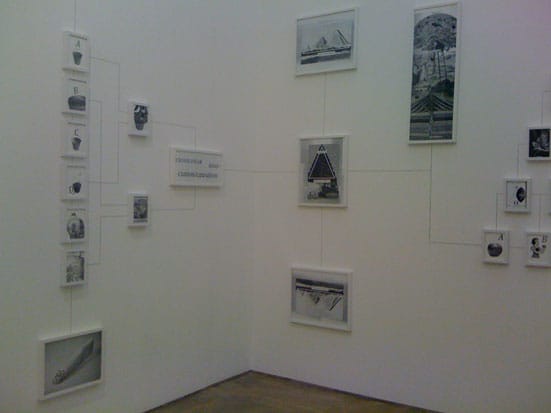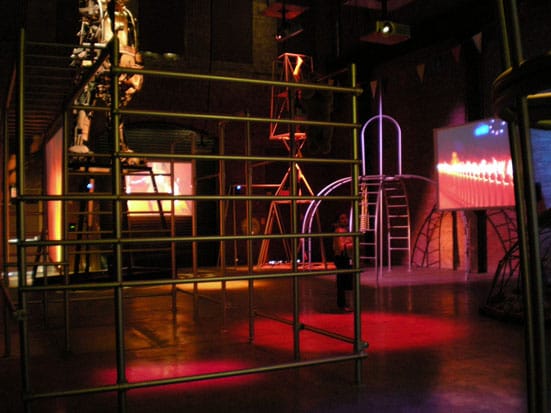I was in New York for a week in November, and caught the first few days of Performa 09, the three-week long performance biennial run by RoseLee Goldberg. As it happened, the initial week was woefully disorganised, with the head quarters at Cooper Union seeming more like backstage at a beauty contest than an information "hub". I guess you can forgive this when 40 venues, 25 curators and 100 artists are involved. I was sorry to miss the second and third week of Performa 09, which contained such gems as performances by Deborah Hay and Yvonne Rainer, a church dance devised by Mike Kelley, a talk show hosted by Omer Fast, an opera by William Kentridge, a theatre production by Keren Cytter at the Kitchen.
However, there was much else to see and experience in New York. PS1's major contribution to Performa09 was an exhibition cramming in a semi-comprehensive history of performance into three small rooms, with screens upon screens crowding the walls. PS1's affiliation with MoMA since 2000 was underlined with an exhibition entitled 1969, displaying works from the MoMA collection - from 1969. Thirty-year old works by artists such as Joseph Beuys, Carl Andre, Sol LeWitt, Joseph Kosuth and several Fluxus artists were interspersed with works from the Bruce High Quality Foundation, whose household items with music and one-liner titles compared unfavourably to the "old masters". Despite a smattering of some interesting works by artist such as Chitra Ganesh, Pipilotti Rist and Leandro Erlich across the vast ex-school building and the inclusion of a more experimental space curated by the its curatorial assistants, PS1 is beginning to feel too much like a wing of MoMA, rather than the dynamic, ground-breaking space it was under Alanna Heiss, who left PS1 in 2008. Nearby Sculpture Centre had a more experimental profile with the catacombs below displaying young artists, while Mike Kelley and Michael Smith dominated the cavernous upstairs space with a cacophonic installation with a multi-screen depiction of Smith as baby IKKI, surrounded by props and set to booming rave music that echoed the site of his performance.
The Bruce High Quality Foundation were to crop up repeatedly ad nauseam across the New York art scene, as did Dexter Sinister, a publisher and graphic design studio in the Lower East side. Dexter Sinister had their own events at Blank Sl8 as part of Performa09 and designed the First/Last Newspaper, which was presented in six issues during the course of the biennial. They were also part of the exhibition Avant-Guide to NYC: Discovering Absence at apexart, which chartered the activities of artists in Manhattan since the 1940s, including René Block, Peggy Guggenheim, George Maciunas and Seth Siegelaub's galleries, Gordon Matta-Clark's Food, Marcel Duchamp and Robert Rauschenberg's studios and John Cage, Merce Cunningham, Yoko Ono and La Monte Young's respective lofts. This exhibition marked the culmination of a sense of nostalgia that seemed omnipresent, whereby younger artists are constantly reworking, revisiting or simply remembering pivotal works created at various staged of the 20th century up to around 1980. This is not just a New York phenomenon; it is also prevalent in London, as well as at the European Kunsthalle at Ludlow 38 on the Lower East Side. Whilst this tendency does invoke pleasurable memories, it does beg the question whether our generation of artists are merely amassing a range of quotations, drawn from the originality of the 20th century avant-garde.
Two exhibitions in New York defied this trend. The first was the Reflections on the Electric Mirror: New Feminist Video at the Elizabeth A. Sackler Center for Feminist Art at the Brooklyn Museum. Several younger artists used the camera to record witty, absurd and affective performances. Highlights included Shannon Plumb's Commercials (2002) where she performs, Charlie Chaplin style, in black and white mock-commercials for daft products. Swedish artist, Klara Liden, employs a similarly comical approach, dancing and conducting a clumsy striptease on the Stockholm metro to what appeared to be frenzied Balkan beats. The onlookers' responses to the solo shindig of this buxom woman in Sapphic street wear were priceless. While employing the video camera as a confessional medium, the artists in this exhibition – such as Cathy Belgien with her Blackout video recounting a boozy night with friends – departed from their 1970s feminist predecessors by employing contemporary popular culture references and self-mockery to ambiguous comic effect.
The other was Alexandre Singh's exhibition at Harris Lieberman in the West Village.
There is an element of nostalgia in Singh's work, though it is associated with a long-gone era of Chaucerian storytelling, gothic horror novels and alchemical magick. These reference points dovetail with contemporary phenomena such as IKEA, Adidas and meth labs in Singh's practice. In Assembly Instructions (Tangential Logic) collages in various shades grey, made up of photocopied snippets from liturgical books, academic texts and fairytales, are meticulously arranged and contained within strict geometric forms on the wall. Hand-drawn lines interlink the diverse material offering a window onto a weird and wonderful fantasy world of cryptic symbolism, spurious cross-references and imaginary maps. Sadly, I missed his 3 Lectures + 1 Story = 4 Evenings at White Columns the following week. This underlined the pervading sense that the first week of Performa09 is a mess best missed, saving the best for weeks two and three. Thankfully, there were other great things to see in New York, including the ISCP Open Studios, with the work of 40 youngish artists from all over the world, whose work, mercifully, broke the monotony of an art scene otherwise awash with semi-incomprehensible "diverse" and derivative practices and colourful, borderline decorative, paintings.
Natalie Hope O'Donnell

Alexandre Singh, Assembly Instructions (Tangential Logic), Harris Lieberman New York (2009)
Photograph by: Natalie Hope O'Donnell (installation shot)

Alexandre Singh, Assembly Instructions (Tangential Logic), Harris Lieberman New York (2009) Photograph by: Natalie Hope O'Donnell (detail)

Mike Kelley and Michael Smith, A Voyage of Growth and Discovery, Sculpture Centre, New York 2009) Photograph by: Natalie Hope O'Donnell (installation shot)